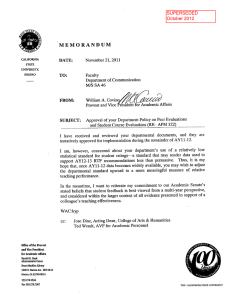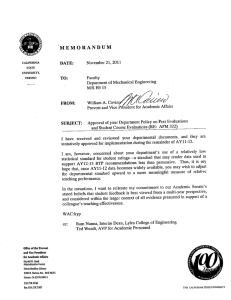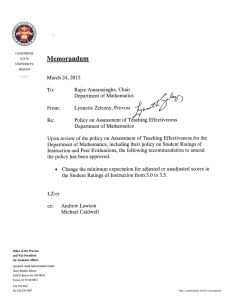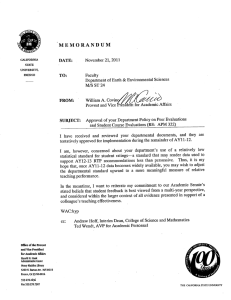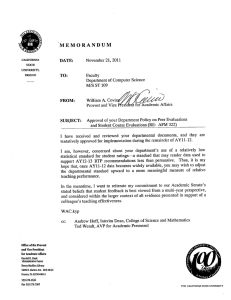MEMORANDUM October 10, 2011 To: Stefaan Delcroix
advertisement
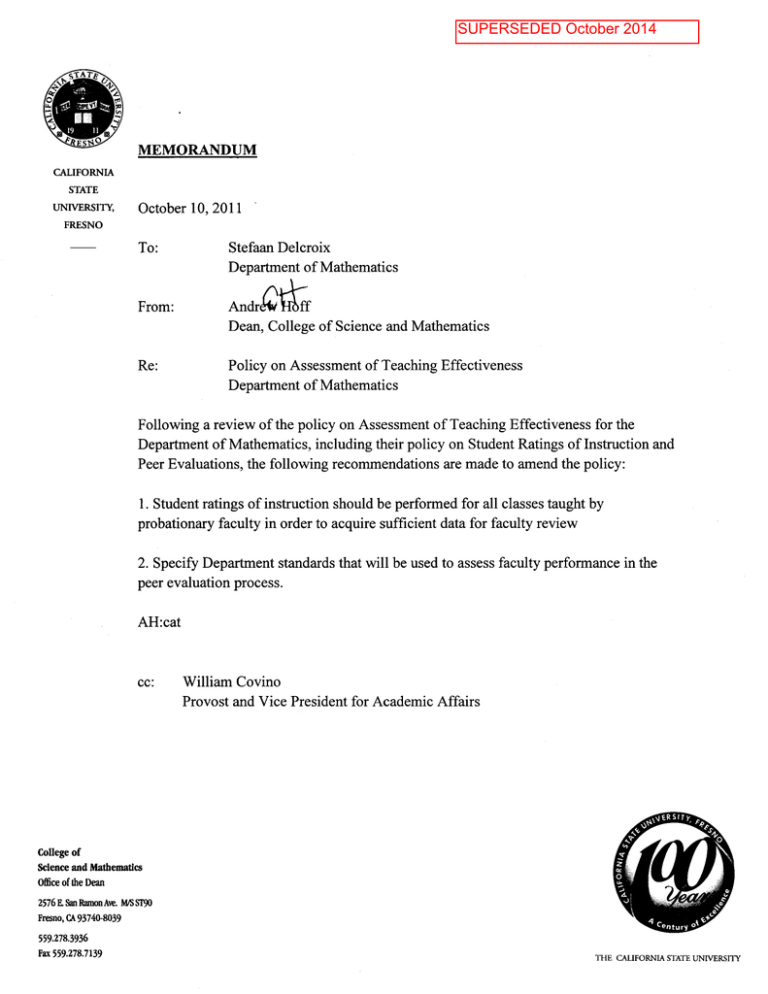
SUPERSEDED October 2014 MEMORANDUM CALIFORNIA STATE UNIVERSITY, October 10, 2011 FRESNO To: Stefaan Delcroix Department of Mathematics From: Andr tIlitf Dean, College of Science and Mathematics Re: Policy on Assessment of Teaching Effectiveness Department of Mathematics Following a review of the policy on Assessment of Teaching Effectiveness for the Department of Mathematics, including their policy on Student Ratings of Instruction and Peer Evaluations, the following recommendations are made to amend the policy: 1. Student ratings of instruction should be performed for all classes taught by probationary faculty in order to acquire sufficient data for faculty review 2. Specify Department standards that will be used to assess faculty performance in the peer evaluation process. AH:cat cc: William Covino Provost and Vice President for Academic Affairs College of Science and Mathematics Office of the Dean 2576 E. San Ramon Ave. MIS 5190 Fresno, CA 93740-8039 559.278.3936 Fax 559.278.7139 THE CALIFORNIA STATE UNIVERSITY SUPERSEDED October 2014 DEPARTMENT OF MATHEMATICS POLICY ON ASSESSMENT OF TEACHING EFFECTIVENESS APM 322 is the official policy on the Assessment of Teaching Effectiveness. This Departmental policy is designed to further define requirements at the Departmental level as specified in APM 322. STUDENT RATINGS OF INSTRUCTION Each faculty member shall have a minimum of two sections rated by students annually. While the IDEA Short Form will be the standard paper instrument for the campus, faculty may elect to use either the Diagnostic Form or Online version. Student ratings of instruction shall be assessed to identify patterns and trends of teaching performance and effectiveness. It is expected that the faculty member shall meet or exceed on a regular basis one of the following department standards: • • 3.0 out of 5.0 using adjusted or unadjusted scores, whichever are higher. a converted average (when compared to all classes in the IDEA Database) in the gray area (Similar) or above (Higher or Much Higher). However, it is more important to evaluate faculty on the basis of multi-year trends rather than focusing on a single course or narrow time frame. PEER EVALUATIONS 1. Frequency a. For part-time temporary faculty, the first time a course is taught by the instructor and, thereafter, at least one section every other year of employment regardless of a break in service. b. For full-time temporary faculty, two sections each semester for the first year and two sections each academic year thereafter. c. For probationary faculty, at least two sections (to include as many different courses as possible) every semester or all sections if fewer are taught in a semester. d. For tenured faculty, one section each academic year on a rotating basis such that during a five year period the maximum number of different courses is evaluated. 2. Faculty will use the attached departmentally approved form to evaluate Course Content, Instructional Design, Instructional Delivery and Assessment methods. 3. The peer evaluations must be completed and turned in by the end of 10 th week of instruction. Last Updated: 9/21/11 APM 322b SUPERSEDED October 2014 PEER REVIEW REPORT: CLASS SESSION Faculty being reviewed. Course. Nature of today's session. Topic. Reviewer: Date. Evaluate the instructor's performance on the following items, using this five-point scale: 5-outstanding 4-good 3-average 2-below average 1-inadequate 1. Syllabus: Course content, course goals, primary learning outcomes, assignment and exam schedule, grading method. 2. Effectiveness of opening discussion and achieving appropriate closure of class. 3. Knowledge of subject matter and quality of preparation. 4. Command of language and clarity of articulation. 5. Organization of lecture, flow of material, clarity of analysis, etc. 6. Instructional design: effective and appropriate use of lecture, group discussion, technology, etc. 7. Presentation of material: concrete examples, appropriate visual aids, avoidance of irrelevant digressions, focus on central materials, etc. 8. Speech: voice quality, clarity, appropriate pacing, avoidance of monotony, etc. 9. Enthusiasm: for subject matter and in presentation. 10. Rapport with class; skill in discussions, answering questions, responding to comments. 11. Ability to convey importance of material and stimulate interest in subject-matter. 12. Methods of assessment: assignments, exams, etc. (appropriate level/frequency) 13. Overall effectiveness of class section. COMMENTS:
